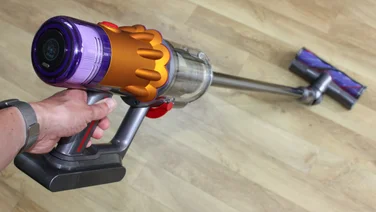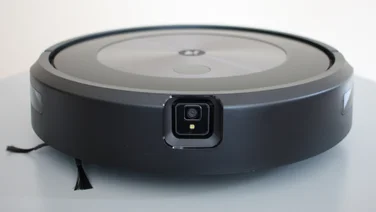To help us provide you with free impartial advice, we may earn a commission if you buy through links on our site. Learn more

Vacuuming your floors on a regular basis is a must if you want to keep your home dust-free. But did you know that after all this hard work, your vacuum’s filters need a good dusting too?
Cleaning the internal parts of a vacuum isn’t always straightforward, and it’s tempting to leave the task until later and hope for the best. If your vacuum’s filters are clogged, however, then doing nothing is the worst thing you can do. Dust buildup in the filters can seriously hinder your vacuum’s performance and even damage it.
So, if your vacuum’s filters are begging for some TLC, but the thought of taking your appliance apart makes you nervous, and terms like “HEPA” and “pre-motor” have you scratching your head, follow our guide on how to clean a vacuum filter.
READ NEXT: Best cordless vacuum cleaners
Why do you need to clean the filters?
The most obvious symptoms of dirty filters are poor suction and a bad odour when in use, but these are just the tip of the iceberg. Neglecting your filters decreases airflow in your appliance, putting extra pressure on the motor and making it more likely to overheat and break. Vacuuming with clogged filters also risks blowing dust back into your room and exposing the internal parts of the appliance to debris, as the parts will struggle to do their job properly.
What is the difference between a pre-motor and a post-motor filter?
Your vacuum is likely to have at least two filters to process the air as it enters and leaves the appliance:
- The pre-motor filter: traps dust before air flows past the motor, preventing it from building up inside the vacuum.
- The post-motor filter: stops finer particles from leaving the machine. It’s also known as the exhaust filter.
READ NEXT: Best Shark vacuum cleaners
What types of filters are there?
There are several types of filters suitable for different models of vacuum. For example, in bagged cleaners, the dust bag itself can be part of the filtration system as the dust is stopped from flowing through the tiny holes in the fabric or paper.Most vacuums have multiple types of filters, in a Henry, for instance, the dust bag is supported by a round cloth filter that sits on top of it.
In a bagless model, like many of Dyson’s vacuums, you can often find a cyclone filter. These are cylindrical plastic chambers that separate dust from the air as they spin inside. Cyclone filters are likely to work alongside porous filters such as foam, felt or cartridges (cylinders or rectangles of pleated paper or fabric in plastic casing).
What is a HEPA filter?
HEPA (High Efficiency Particulate Air) filters are made of fibres capable of trapping 99.97% of particulates larger than 0.3 microns. As Sophie Lane, product training manager at Miele, explains: “This has the benefit of capturing allergens and bacteria as well as all the usual household dirt and grime”. HEPA filters usually come in the form of cartridges.
READ NEXT: Best vacuum cleaners
Where can you find the filter?
The location of filters in a vacuum will vary between brands and models:
- The filters in cylinder vacuums, whether they’re cartridges, cyclones, cloth or felt, are usually under the lid, near the dust compartment of the appliance.
- Similarly, most robot and handheld vacuum filters should be easy to hunt down once you have your hands on the dust bin.
- The trickiest filters to locate tend to be in upright vacuums. The less compact design means that there’s likely to be a filter or two by the dust bin, as well as a post-motor filter somewhere further along the appliance.
Check how many filters your vacuum has and where to find them in the user manual if you need to.
How to clean a vacuum filter
1. Unplug your vacuum.
2. Empty the dust bag or compartment, then remove the filters. This should be relatively easy, most vacuums will have mechanisms such as release buttons to help you get to the filter.
3. Detach as many parts as possible. Don’t separate cartridges, but if you have a cloth, sponge or felt filter in a removable casing you’ll want to clean the parts individually.
4. Clean the filter.
Bag filter: Simply empty (reusable) or replace (disposable) the dust bag.
Cloth filter: Tap and shake the dust out by a bin. If you have access to another vacuum cleaner, run it along the inside and outside of the filter. Only wash the cloth in water if the manufacturer states that it’s okay to do so.

Cyclone filter: Tap and shake the dust out by a bin, then rinse the part with cold water until the water runs clear.
Foam or felt filter: First shake out the dust and debris. Next, rinse the filter with cold water, squeezing gently, until the water runs clear. If you’re tempted to use a bit of washing up liquid, check your appliance’s manual first, as some manufacturers advise against this.
Cartridge filter (including HEPA): Tap the filter on the side of a bin to shake off dust. Some cartridges are washable, but many are not. If you have a washable cartridge (check manual) rinse it with cold water.
Otherwise, wiping the cartridge with a dry cloth or gently dislodging debris out of the ridges with a small bristle brush should help.

5. If you washed your filter, you’ll need to wait for it to dry completely. This can take 24 hours or more, but don’t try to speed up the process by using a hair dryer or any other appliance as exposing the filter to excessively high temperatures can cause deformation. Simply leave the filters in a well-ventilated room.
READ NEXT: Best handheld vacuum cleaners
How often should you clean it?
Catrin Davies, senior product manager at SDA Hoover, suggests that for best performance, the filters and bin of your vacuum should be cleaned at least once a month. Of course, how often you use your vacuum and what type of filters you have will impact how much maintenance they need. It’s always worth checking the manual for a cleaning schedule specific to your vacuum.
When should you replace the filter?
Most manufacturers recommend replacing the filters in your vacuum every few months.
Pleated, non-washable filters especially, are often designed to be replaced, and some will even have an indicator to let you know when it’s time to change filters.
Even if your filters don’t come with indicators, if cleaning doesn’t improve their condition or they look worn and misshapen, these are pretty good signs that a filter replacement is in order.






